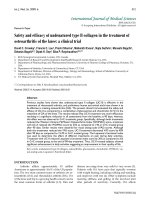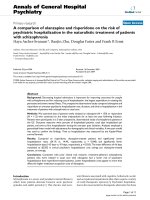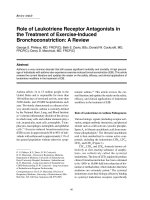Báo cáo y học: "Special considerations in the treatment of patients with bipolar disorder and medical co-morbidities"
Bạn đang xem bản rút gọn của tài liệu. Xem và tải ngay bản đầy đủ của tài liệu tại đây (346.3 KB, 10 trang )
BioMed Central
Page 1 of 10
(page number not for citation purposes)
Annals of General Hospital
Psychiatry
Open Access
Review
Special considerations in the treatment of patients with bipolar
disorder and medical co-morbidities
Kimberly D McLaren and Lauren B Marangell*
Address: Mood Disorders Center, Menninger Department of Psychiatry, Baylor College of Medicine, Houston, TX, USA
Email: Kimberly D McLaren - ; Lauren B Marangell* -
* Corresponding author
bipolar disordermedical illnessobesitydiabetes mellitusdyslipidemiacardiac diseasehepatic diseaserenal diseasepulmonary diseasecancer-mood stabilizersanticonvulsantsatypical antipsychotics
Abstract
Background: The pharmacological treatment of bipolar disorder has dramatically improved with
multiple classes of agents being used as mood-stabilizers, including lithium, anticonvulsants, and
atypical antipsychotics. However, the use of these medications is not without risk, particularly
when a patient with bipolar disorder also has comorbid medical illness. As the physician who likely
has the most contact with patients with bipolar disorder, psychiatrists must have a high index of
suspicion for medical illness, as well as a basic knowledge of the risks associated with the use of
medications in this patient population.
Methods: A review of the literature was conducted and papers addressing this topic were selected
by the authors.
Results and discussion: Common medical comorbidities and treatment-emergent illnesses,
including obesity, diabetes mellitus, dyslipidemia, cardiac disease, hepatic disease, renal disease,
pulmonary disease and cancer are reviewed with respect to concomitant use of mood stabilizers.
Guidance to clinicians regarding effective monitoring and treatment is offered.
Conclusions: Mood-stabilizing medications are necessary in treating patients with bipolar
disorder and often must be used in the face of medical illness. Their safe use is possible, but requires
increased vigilance in monitoring for treatment-emergent illnesses and effects on comorbid medical
illness.
Background
Patients with bipolar disorder are among the most chal-
lenging to treat pharmacologically, especially in the pres-
ence of medical comorbidity. Although the rates of
medical comorbidity are high in patients with bipolar dis-
order (20–80%), medical illnesses are frequently under-
diagnosed and inadequately treated in psychiatric
patients. For example, Cradock-O'Leary and colleagues
reviewed centralized Veterans Affairs data and examined
the use of medical services by 175,653 veterans during fis-
cal year 2000 [1]. They identified 3,694 veterans with a
primary diagnosis of bipolar disorder and compared the
care that these veterans received to that of all veterans.
Among all veterans with diabetes and hypertension, those
with a comorbid diagnosis of bipolar disorder (as well as
those with diagnoses of anxiety disorder, schizophrenia,
post-traumatic stress disorder, or a substance use disor-
der) were less likely to have more than one medical visit
Published: 22 April 2004
Annals of General Hospital Psychiatry 2004, 3:7
Received: 21 August 2003
Accepted: 22 April 2004
This article is available from: />© 2004 McLaren and Marangell; licensee BioMed Central Ltd. This is an Open Access article: verbatim copying and redistribution of this article are permit-
ted in all media for any purpose, provided this notice is preserved along with the article's original URL.
Annals of General Hospital Psychiatry 2004, 3 />Page 2 of 10
(page number not for citation purposes)
in one year. This is especially concerning given that veter-
ans are afforded medical and psychiatric treatment within
one comprehensive health care system, seemingly making
care more accessible. Patients with bipolar disorder in the
general population are likely receiving even less medical
care. The significance of this finding is that the psychiatrist
may be the only physician caring for these patients on a
regular basis. Therefore, psychiatrists must have a high
index of suspicion for medical illness, as well as a basic
knowledge of the risks associated with the use of medica-
tions in this patient population.
The purpose of this paper is to identify common medical
comorbidities in bipolar disorder, including those that are
treatment–emergent, and to offer guidance to clinicians
regarding effective monitoring and treatment.
Material and methods
An extensive review of effective pharmacotherapies is
beyond the scope of this paper which will perform a selec-
tive review the psychotropic medications often prescribed
to patients with bipolar disorder, with an emphasis on
their use in patients with medical comorbidity. More spe-
cifically, the review results include papers concerning
bipolar patients with obesity, diabetes mellitus, dyslipi-
demia, cardiac, hepatic, renal and pulmonary disease and
cancer.
It is essential to keep in mind that benefit cannot be
deleted from the risk:benefit analysis. In some cases a
medication with greater side effects or medical risk may be
the preferred treatment because of the documented effi-
cacy of the agent either in general, or in a particular
patient.
This paper will perform a selective review of the psycho-
tropic medications often prescribed to patients with bipo-
lar disorder, with an emphasis on their use in patients
with medical comorbidity. Currently, lithium, valproate,
olanzapine, lamotrigine, risperidone and quetiapine are
indicated for use in bipolar disorder by the US Food and
Drug Administration (FDA). Aripiprazole has recently
been submitted to the FDA for approval in the treatment
of bipolar disorder. Other agents are also used as adjuncts,
despite limited efficacy data. As such, mention of a medi-
cation in this article does not necessarily imply efficacy,
and the reader is referred to the American Psychiatric
Association practice guideline for Bipolar Disorder
(2002).
Results and discussion
Obesity
Obesity is a leading cause of preventable death in the
United States, with an estimated 300,000 people dying
annually of obesity-related causes [2]. Although the gen-
eral population in the United States is increasingly more
overweight and obese, 64.5% and 30.5%, respectively, in
a 1999–2000 survey, individuals with bipolar I disorder
are still slightly more likely to be obese [3]. Fagiolini and
colleagues found that 35.4% of patients with bipolar dis-
order were obese. Pharmacotherapy and affective epi-
sodes both influence appetite and physical activity,
thereby increasing the risk for obesity. Obesity in bipolar
patients is correlated with a greater number of lifetime
depressive and manic episodes, a more severe and diffi-
cult-to-treat index episode, and a greater risk of develop-
ing an affective recurrence, most often depression [4].
Persons with bipolar disorder are more likely to be over-
weight (body mass index [BMI] of 25–29.99 kg/m2) or
obese (BMI of 30 kg/m2 or greater) even when mood is
euthymic. Elmslie and colleagues found the prevalence
rates for obesity and being overweight in euthymic female
bipolar patients were 1.5 and 1.8 times greater, respec-
tively, when compared to the reference group [5]. Obesity
was also more prevalent in male euthymic patients com-
pared with the reference group. In both male and female
bipolar patients, truncal obesity was most prominent.
This pattern of obesity reflects fat that is distributed cen-
trally between the thorax and pelvis and is associated with
increased risk of type 2 diabetes mellitus, dyslipidemia,
hypertension, stroke, ischemic heart disease and early
mortality [6-9]. The authors concluded that the preva-
lence of obesity in this study of outpatients was related to
the use of antipsychotics, but less so lithium or anticon-
vulsants. Of those persons prescribed no psychotropics,
less than 10% were obese, suggesting that bipolar disorder
itself does not cause obesity, and that pharmacologic
treatment and gender are greater influences [10].
Important factors influencing obesity in bipolar patients
include nutrient intake and physical activity. In assessing
the nutrient intake of persons with bipolar disorder,
Elmslie and colleagues found that they had increased
intake of carbohydrates and sweets, especially non-alco-
holic sweetened drinks [5]. The intake of sucrose was
higher in patients, particularly females, receiving antipsy-
chotics than in those receiving other or no medications.
Patients with bipolar disorder were also more sedentary,
exercising less frequently and with less intensity than ref-
erence subjects. Medication side effects such as dry mouth
and increased thirst may lead to increased consumption
of sweetened drinks. Sedation, decreased motivation and
impaired coordination may promote physical inactivity.
Obesity in patients with bipolar disorder should not be
the only factor used to inform selection of psychotropics.
In fact, patients who are obese at baseline may be less
likely to have significant weight gain than those with a
lower baseline body mass index. At the same time,
Annals of General Hospital Psychiatry 2004, 3 />Page 3 of 10
(page number not for citation purposes)
though, use of certain psychotropic medications may
make it more difficult for those patients to lose weight.
Patients should be weighed at baseline and again two
weeks after beginning treatment. If the patient gains four
pounds or more, behavioral interventions of diet and
exercise and a consultation with a nutritionist should be
considered. Specific dietary modifications should include
avoidance of refined carbohydrates, including sweetened
drinks, increased intake of omega-3 fatty acid, and small
amounts of protein with each meal [11]. Behavioral inter-
ventions can lead to significant loss of weight gained
while taking atypical antipsychotics, and the modifica-
tions of eating and exercise habits help patients maintain
the weight loss [12].
Pharmacologic treatment of obesity should be avoided if
at all possible, given the risk of side effects and drug inter-
actions. Pharmacologic agents should be reserved for
those patients with a BMI of 30 kg/m2 or greater, or a BMI
of 27 kg/m2 or greater and risk factors for weight related
medical illnesses [12]. Agents associated with weight loss
include metformin [13-15], topiramate [16], sibutramine
[12], amantadine [18,19], nizatidine [19] and orlistat
[20]. Centrally acting agents have a theoretical risk of
exacerbating psychosis or mood disorders and should be
used with caution [22,23].
Gastric restrictive surgical interventions may be consid-
ered for patients whose BMI exceeds 40 kg/m2 and who
have not responded to behavioral interventions or phar-
macologic treatment [12].
Diabetes mellitus
Cassidy and colleagues reported the prevalence of diabe-
tes mellitus in hospitalized bipolar patients to be approx-
imately three times the national average [24]. Further,
bipolar patients with diabetes mellitus had more lifetime
psychiatric hospitalizations than non-diabetic bipolar
patients. It is prudent, therefore, for psychiatrists to be
aware of the risk factors associated with diabetes, includ-
ing treatment-emergent diabetes. Recent publications
linking atypical antipsychotics with treatment-emergent
diabetes are numerous, but often contradictory. There are
reports of hyperglycemia associated with risperidone,
quetiapine and ziprasidone, and more frequently with
clozapine and olanzapine [26,27].
Of note, those with baseline risk factors for diabetes mel-
litus are more likely to develop treatment-emergent diabe-
tes (TED). Sowell identified risk factors for patients who
entered clinical trials and later developed TED [28]. At
study entry these patients had higher random glucose lev-
els, were older, more obese and more likely to possess
multiple risk factors for DM. Neither treatment-emergent
weight gain nor treatment group significantly impacted
the risk for TED. Established risk factors for diabetes
include: family history, ethnicity, increasing age, central
obesity, physical inactivity, low HDL/high triglycerides,
fasting glucose of 110 mg/dL or greater, gestational diabe-
tes, hypertension, and polycystic ovary syndrome.
Though questions remain about the pathophysiology of
treatment-emergent diabetes, guidelines are being formu-
lated to aid clinicians in identifying patients at risk.
Screening for diabetes should include questioning
patients about symptoms such as excessive thirst and uri-
nation, nocturia, unexplained weight loss, fatigue, fre-
quent infections, and blurred vision. Recommendations
for fasting glucose screening at baseline and follow-up for
patients receiving atypical antipsychotics are presented in
Table 1[29].
Dyslipidemia
The effects of atypical antipsychotics on lipid levels have
been reported primarily in patients with schizophrenia.
Studies of patients on atypical antipsychotics, as well as
high potency neuroleptics, show a significant association
between weight gain and cholesterol and triglyceride ele-
vation in patients with schizophrenia. This association is
most commonly observed in patients prescribed clozap-
ine and olanzapine, reaching statistical, though not neces-
sarily clinical significance [26,30-33]. Olanzapine,
risperidone and quetiapine have also been shown to
decrease mean low-density lipoprotein (LDL) levels, and
olanzapine may also lower mean high-density lipoprotein
(HDL) levels [30]. Some studies indicate that ziprasidone
may lower cholesterol and serum triglycerides [27]. As
such, some authors recommend monitoring body weight,
fasting cholesterol and triglycerides at baseline and every
six months in routine clinical practice with all antipsy-
chotics [26].
Table 1: Diabetes Mellitus Screening Recommendations For Patients Treated with Atypical Antipsychotics [29]
Initiation of Treatment • Baseline fasting glucose level
First Year of Treatment • Fasting glucose level every 3–4 months
• Observe for signs of hyperglycemia
Duration of Treatment • Fasting glucose level every 6 months in high-risk patients
• Fasting glucose level every 12 months in patients with normal glucose
levels during first year of therapy
Annals of General Hospital Psychiatry 2004, 3 />Page 4 of 10
(page number not for citation purposes)
The effects of anticonvulsants on serum lipid and choles-
terol levels have been studied primarily in patients with
seizure disorders. Carbamazepine-induced increase in
total cholesterol is primarily due to an increase in HDL
[34]. This occurs during the initial weeks of therapy, per-
sists throughout treatment and reverses in the first few
weeks after discontinuation. A 5-year prospective study of
patients treated with carbamazepine also revealed a tran-
sient increase in LDL cholesterol and triglycerides in the
first year of treatment [35]. When carbamazepine was
replaced with oxcarbazepine in patients with seizure dis-
orders, total serum cholesterol levels decreased, but HDL
cholesterol and triglyceride levels remained unchanged
[36].
Women with obesity and polycystic ovaries or hyperan-
drogenism treated with valproate have also been shown to
have elevations in serum triglycerides and low HDL to
total cholesterol ratios [37,38]. This is consistent with
insulin resistance in this population. Valproate does not
appear to contribute to clinically significant dyslipidemia
across other populations [38,39]. The effects of lamotrig-
ine and topiramate on serum cholesterol and triglyceride
levels have been reported in small studies and case reports
[16,38]. Neither of these anticonvulsants appears to affect
lipid levels.
Currently there are no published recommendations for
monitoring serum lipids in patients receiving anticonvul-
sants. In patients identified as having polycystic ovaries or
hyperandrogenism, monitoring of lipid levels is
warranted.
Cardiac disease
As discussed above, patients with bipolar disorder have a
higher prevalence of cardiac risk factors, such as obesity,
glucose dysregulation and dyslipidemia. It is not surpris-
ing, therefore, that patients with bipolar disorder also
have greater mortality from cardiovascular disease com-
pared with the general population [40]. Further, many of
the medications that treat bipolar disorder may have car-
diac side effects or toxicity. Underlying cardiac disease
may also affect the pharmacokinetics of psychotropics.
Congestive heart failure (CHF) can affect pharmacokinet-
ics in various ways. Diminished cardiac output results in a
shift of blood flow to vital organs. This may lead to
decreased perfusion of the gastrointestinal tract and skel-
etal muscle with resultant erratic absorption of oral and
intramuscular medications, increased drug delivery to
brain tissue, reduced blood flow to kidneys with resultant
slowed clearance and prolonged elimination half-lives.
Though studies supporting dosing guidelines for psycho-
tropics in CHF are lacking, it has been recommended that
medication doses be reduced by 50% in patients with
CHF [41].
Lithium has been shown to both induce and ameliorate
CHF. In therapeutic doses, lithium probably does not
decrease cardiac contractility. However, if CHF symptoms
worsen, lithium should be discontinued [42]. Patients
with CHF are also at increased risk for orthostatic hypo-
tension, specifically with medications that antagonize
alpha-1 receptors [43]. Medications with significant
alpha-1 blockade include low-potency neuroleptics and
atypical antipsychotics (quetiapine > risperidone > olan-
zapine/ziprasidone). Lithium and anticonvulsants are not
alpha-1 antagonists [44].
Patients with preexisting intraventricular conduction
delays are at increased risk for complete heart block when
given medications with quinidine-like properties, includ-
ing carbamazepine and tricyclic antidepressants [45]. Val-
proate has no known adverse cardiac effects [46]. Lithium
is associated with sinus node dysfunction, which is usu-
ally reversible with discontinuation of medication [42].
There is sparse evidence for first-degree atrial-ventricular
(AV) block and rare reports of aggravation of ventricular
arrhythmias with lithium at therapeutic levels. However,
lithium toxicity may be associated with sinoatrial block,
AV block, AV dissociation, bradyarrhythmias, ventricular
tachycardia, and ventricular fibrillation. T-wave flattening
or inversion with therapeutic lithium levels are of uncer-
tain clinical significance and are usually reversible upon
discontinuation of lithium therapy [42].
Prolongation of the QTc interval on electrocardiograph
(ECG) in the context of antipsychotic medication use has
received increased attention in recent years. Prolongation
of the QT interval greater than 500 ms increases the risk of
torsade de pointes, a polymorphic ventricular tachycardia
that is associated with syncope and sudden death. Several
antipsychotics have been documented to cause torsade de
pointes and sudden death, including pimozide, sertin-
dole, droperidol, haloperidol, and thioridazine, which
has the greatest risk [47]. Risperidone-induced QT prolon-
gation has been observed, including one fatality, though
torsade de pointes was not reported [48]. Ziprasidone has
also been associated with prolongation of the QT interval;
however, to date, no cases of ziprasidone-associated tor-
sade de pointes or sudden death have been reported in the
literature or to the Federal Drug Administration. It should
be pointed out, though, that most of the safety data on
ziprasidone to date originates from clinical trials, with
selective entry criteria likely to exclude patients who are
susceptible to torsade de pointes and sudden death.
A study of the effects of six antipsychotics on the QT inter-
val found that thioridazine produced the most prolonga-
Annals of General Hospital Psychiatry 2004, 3 />Page 5 of 10
(page number not for citation purposes)
tion (mean change of 35.6 ms), followed by ziprasidone
(20.3 ms), quetiapine (14.5 ms), risperidone (11.6 ms),
olanzapine (6.8 ms), and haloperidol (4.7 ms)
[47,49,50]. These findings are difficult to interpret given
that quetiapine and olanzapine have not been implicated
in cases of torsade de pointes or sudden death, but pro-
duced greater prolongation than haloperidol, which has
been associated with the fatal arrhythmia.
At this time, routine ECG screening and monitoring has
not been recommended before initiating treatment with
antipsychotics. However, a careful medical history should
be taken for symptoms of cardiac pathology, such as
recurrent syncope. A family history of early sudden death
should be obtained and serum electrolyte imbalances
should also be corrected as these may predispose patients
to arrhythmias. It has been suggested that ECG monitor-
ing be undertaken in patients at higher risk, including
those with cardiovascular disease, a history of QT prolon-
gation, polypharmacy (metabolic inhibitors or other
drugs known to affect the QT interval), high doses of
antipsychotics, or symptoms possibly related to arrhyth-
mias (syncope, palpitations, dizziness, etc.). The QTc
interval may not reliably predict the risk for arrhythmia;
however, an examination of the ECG by a cardiologist for
other signs of arrhythmia may facilitate a more useful
assessment of risk [50].
Patients with recent myocardial infarction (MI) are at
increased risk for arrhythmias, heart failure and sudden
death and are frequently treated with numerous medica-
tions, thereby increasing the likelihood for drug interac-
tions with psychotropic medications. Lithium may be
used after MI, but care must be taken to monitor for and
correct any electrolyte aberrations. Of note, lithium in
combination with angiotensin converting enzyme (ACE)
inhibitors may produce an increased risk of arrhythmia
[42,51]. Valproate has an increased risk of liver injury in
conjunction with lipid-lowering agents, as well as risk of
bleeding complications when taken with antiplatelet
agents, warfarin or niacin. Carbamazepine acts as an
inducer of cytochrome 3A4, which may increase the
metabolism of some anticoagulant and cardiovascular
medications. Olanzapine may induce or worsen cardiac
risk factors such as obesity, metabolic derangements and
hyperlipidemia. Quetiapine and risperidone may also
contribute to obesity. Ziprasidone should be avoided due
to increased risk of arrhythmia [51]. Cardiovascular cond-
siderations in the treatment of bipolar disorder are
reviewed in Table 2.
Hepatic disease
Patients with pre-existing liver disease are at increased risk
for liver toxicity due to psychotropic medications. Hepatic
insufficiency increases blood levels and half-lives of all
psychotropic medications, except lithium. Possible mech-
anisms include: decreased oxidative metabolism through
cytochrome enzymes; possible reduction of conjugation
pathways for medications that predominantly undergo
glucuronidation; decrease in hepatic blood flow because
Table 2: Cardiovascular Considerations in the Treatment of Bipolar Disorder
Drug + EKG or Conduction Changes Congestive Heart Failure Orthostatic Hypotension Post-Myocardial Infarction
Lithium * (therapeutic level) Sinus node dysfunction; T wave
flattening/inversion; rare 1
st
degree AV
block & aggravation of ventricular
arrhythmias
May exacerbate symptoms of
CHF; monitor level due to
fluid/electrolyte changes
None Monitor for electrolyte aberrations; in
combination with ACE inhibitors,
increased risk of arrhythmia
(toxicity) Sinoatrial block; AV block/dissociation
bradyarrhythmias; ventricular
tachycardia/fibrillation
Valproate * Unlikely May require decrease in
valproate dose
None Risk of liver injury in conjunction with
lipid-lowering agents; risk of bleeding
complications in conjunction with
antiplatelet agents, warfarin, niacin
Carbamazepine Quinidine-like properties increase risk
of complete heart block
May require decrease in
carbamazepine dose
None Induction of CYP3A4 increases
metabolism of some anticoagulant &
cardiovascular drugs
Olanzapine * Unlikely May require decrease in
olanzapine dose
Minimal Increased cardiac risk factors: weight
gain, metabolic changes and
hyperlipidemia
Ziprasidone QT prolongation; risk of torsade de
pointes
May require decrease in
ziprasidone dose
Minimal Should be avoided due to increased
risk of arrhythmia
Risperidone * Unlikely May require decrease in
risperidone dose
Some orthostatic
hypotenstion
Increased cardiac risk factors: some
weight gain
Quetiapine * Unlikely May require decrease in
quetiapine dose
Significant orthostatic
hypotension
Increased cardiac risk factors: weight
gain
EKG = Electrocardiogram AV = Atrial-Ventricular CHF = Congestive Heart Failure ACE = Angiotensin Converting Enzyme CYP = Cytochrome
P450 + Not all agents are appropriate for monotherapy. Inclusion in this table does not necessarily imply efficacy. * Currently FDA approved for use
in Bipolar Disorder.









